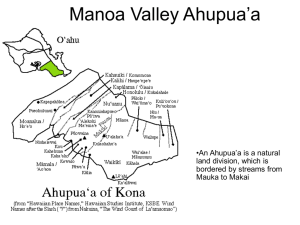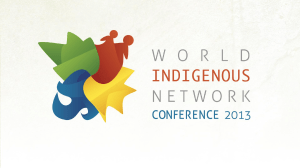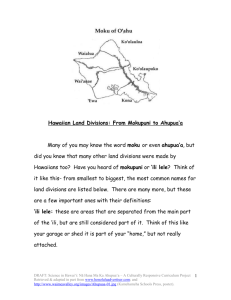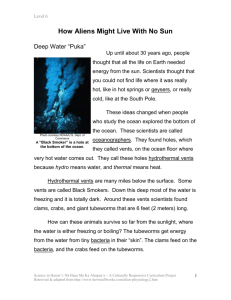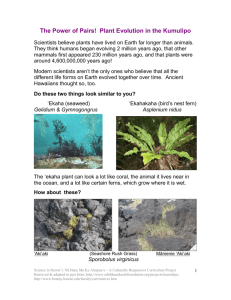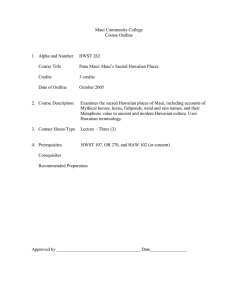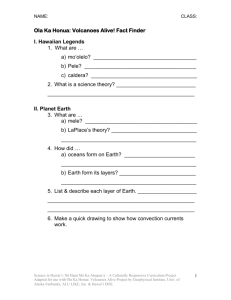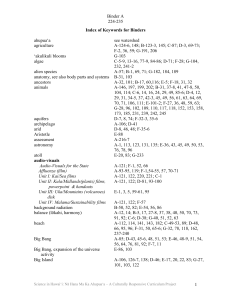2008.12 - Hawaiian Studies (HWST) 207: Malama Ahupua'a - Resource Management, Course Outline
advertisement
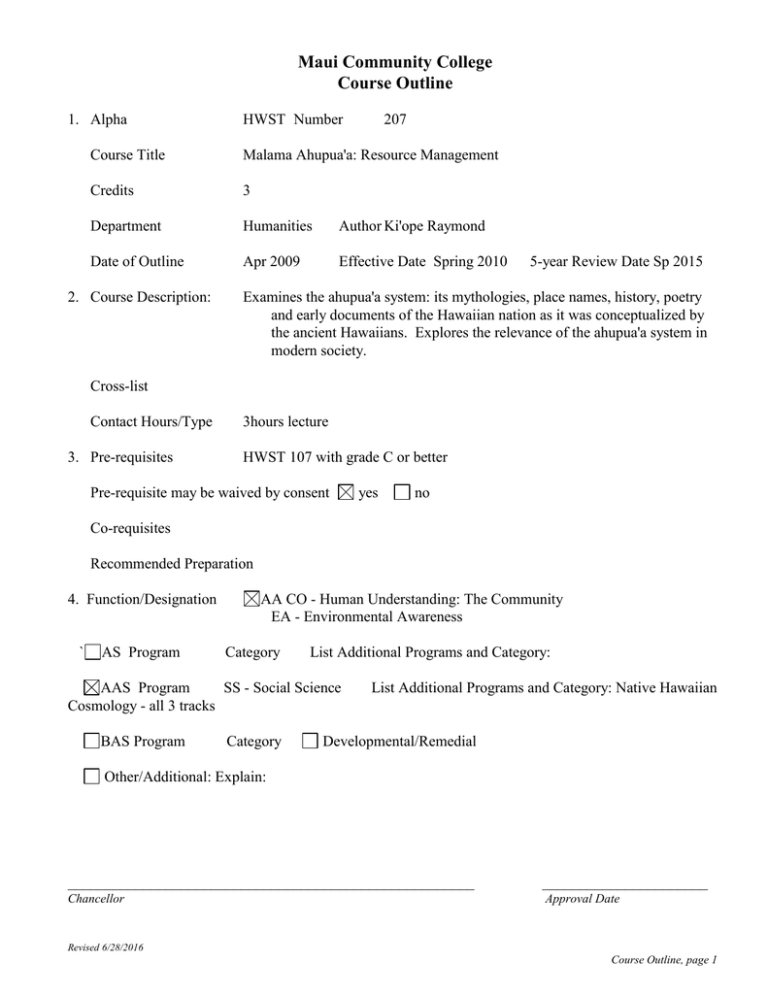
Maui Community College Course Outline 1. Alpha HWST Number 207 Course Title Malama Ahupua'a: Resource Management Credits 3 Department Humanities Author Ki'ope Raymond Date of Outline Apr 2009 Effective Date Spring 2010 2. Course Description: 5-year Review Date Sp 2015 Examines the ahupua'a system: its mythologies, place names, history, poetry and early documents of the Hawaiian nation as it was conceptualized by the ancient Hawaiians. Explores the relevance of the ahupua'a system in modern society. Cross-list Contact Hours/Type 3. Pre-requisites 3hours lecture HWST 107 with grade C or better Pre-requisite may be waived by consent yes no Co-requisites Recommended Preparation 4. Function/Designation ` AS Program AA CO - Human Understanding: The Community EA - Environmental Awareness Category List Additional Programs and Category: AAS Program SS - Social Science Cosmology - all 3 tracks BAS Program Category List Additional Programs and Category: Native Hawaiian Developmental/Remedial Other/Additional: Explain: ______________________________________________________ ______________________ Chancellor Approval Date Revised 6/28/2016 Course Outline, page 1 2 See Curriculum Action Request (CAR) form for the college-wide general education and/or program SLOS this course supports. This course outline is standardized and/or the result of a community college or system-wide agreement. Responsible committee: Revised 6/28/2016 course outline 3 5. Student Learning Outcomes (SLOs): List one to four inclusive SLOs. For assessment, link these to #7. Recommended Course Content, and #9. Recommended Course Requirements & Evaluation. Use roman numerals (I., II. III.) to designate SLOs On successful completion of this course, students will be able to: I. Develops an understanding of the traditional Hawaiian ahupua'a system, cultural uses of various portions, and their relevance in modern Hawai'i; II. III. IV. 6. Competencies/Concepts/Issues/Skills For assessment, link these to #7. Recommended Course Content, and #9. Recommended Course Requirements & Evaluation. Use lower case letters (a., b., c…n.)to designate competencies/skills/issues On successful completion of this course, students will be able to: a. explain and discuss examples of the traditional Hawaiian methods of dividing land, and roles and responsibilities of all sectors of society; b. discuss the traditional and customary Hawaiian land terms and explain their significance and ahupua'a; c. explain the relevance of traditional stories, myths, chants, and poetry to ahupua'a; d. explain how to research and obtain information about historical documents and other resources related to local ahupua'a; e. explain and give examples of land use by island and of traditional uses of land sections (such as ili, moo, kihapai, loi) within ahupua'a as related to environmental conditions and the ethnozoological and ethnobotanical resources; and f. research and develop plans to malama (care for), use, preserve, and protect a selected ahupua'a including land, water and ocean, especially as they pertain to aboriginal rights. 7. Suggested Course Content and Approximate Time Spent on Each Topic Link to #5. Student Learning Outcomes and # 6 Competencies/Skills/Issues 1-2 weeks 1-3 weeks 1-3 weeks 1-3 weeks 1-3 weeks 1-8 weeks 1-8 weeks Introduction to background, geography, and cultural importance of the ahupua'a system (I, a-f) Exploration of maps and place names related to selected moku and ahupua'a (I, b) Traditional stories, myths, chants, and poetry and relevance (I, c) Methods for obtaining information about selected ahupua'a (I, d) Subdivisions and uses of sections within ahupua'a (I, e) Field studies of selected ahupua'a (I, a-f) Research and development of plans to care for, use, preserve, and protect a selected ahupua'a (I, a-f) 8. Text and Materials, Reference Materials, and Auxiliary Materials Appropriate text(s) and materials will be chosen at the time the course is offered from those currently available in the field. Examples include: Draft Management Plan for Ahupua'a of Pu'uwa'a and the Makai Lands Revised 6/28/2016 course outline 4 <www.state.hi.us/dlnr/dofaw/puuwaawaa/draftplanv2.pdf> Appropriate reference materials will be chosen at the time the course is offered from those currently available in the field. Examples include: Appropriate auxiliary materials will be chosen at the time the course is offered from those currently available in the field. Examples include: 9. Suggested Course Requirements and Evaluation Link to #5. Student Learning Outcomes (SLOs) and #6 Competencies/Skills/Issues Specific course requirements are at the discretion of the instructor at the time the course is being offered. Suggested requirements might include, but are not limited to: Research Paper (Ia,b,c,d,e,f) Midterm Exams (2 @100 points each (Ia,b,c,d)+(I,d,e,f) Powerpoint Presentation (Ia,b,c,d,e,f) Final Exam (Ia,b,c,d,e,f) 100 points 200 points 100 points 100 points Total 500 points A = 450-500 points B = 400-449 C = 350-399 D = 300-349 F = < 300 10. Methods of Instruction Instructional methods will vary considerably by instructor. Specific methods are at the discretion of the instructor teaching the course and might include, but are not limited to: a. b. c. d. e. f. g. h. i. j. exams and quizzes with feedback and discussion; lectures and class discussions; problem solving; narrated PowerPoint presentations; videos, DVDs, CD-ROMs with detailed viewing guides and discussion questions; field trips including field notes, activities, observations, and data collection; guest speakers and attendance at public presentations and meetings; oral reports and other student presentations; games and simulations; individual and group class activities and homework assignments such as: - reading and writing summaries and reactions to media reports concerning uses of the land; - mapping selected ahupua'a; - reading text and reference materials and answering discussion questions; - researching land use issues and problems; k. web-based assignments and activities; l. reflective journals; Revised 6/28/2016 course outline 5 m. n. o. p. group and/or individual research projects with reports or other types of presentations; study logs and study groups; Service-Learning, community service, and/or civic engagement projects; and other contemporary learning techniques (such as problem-based learning, investigative case-based learning, co-op, internships, self-paced programs, etc.) 11. Assessment of Intended Student Learning Outcomes Standards Grid attached Revised 6/28/2016 course outline
